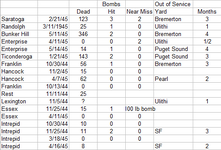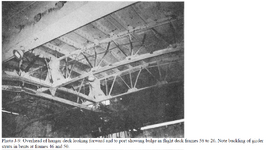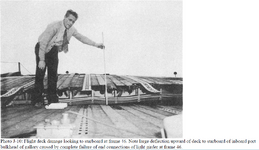There seems to be some cherry picking of information about a Wasp v other carriers in the above comparisons.
Pre-war everyone's carriers were limited by the constraints of the various Treaties. That meant:-
1922-1936 a total tonnage limit (135,000 for US & Britain, 81,000 for Japan). The US enshrined that in domestic law which they only increased by 40,000 tons in Second Vinson Act in 1938, when they didn't need to for international purposes. That US increase allowed the building of Hornet, and an allowance towards Essex.
Add to that limits on individual carrier size (27,000 to 1936, 23,000 thereafter with exceptions for Lexingtons & Akagi & Kaga) but subject to the overall limit.
Wasp was designed to use up the the available Washington tonnage after taking account of what was available by converting Langley CV-1 to a seaplane carrier as permitted by the Treaties, prior to the expiration of the Treaty on 31 Dec 1936. She was being designed when Second London Treaty was being discussed and negotiated and laid down 1 April 1936, just days after that Treaty was agreed. By that time the Japanese had announced their departure from the Treaty system
So here are some numbers from my sources incl Friedman US Aircraft Carriers
Wasp
Standard displacement 14,700 tons
Full load displacement 19,116 tons
Flight deck 727x93 feet
Hangar deck 522x63 feet
Airgroup - 74
By early 1942 her air group consisted of 18xF4F-3, 30xSB2U-2 & 6 TBD-1, total 54. By swapping out the fixed wing F4F-3 for folding wing F4F-4 later in the year and moving to SBD-3 and TBF-1 she was able to increase the airgroup to c65.
Commencement Bay class
Standard displacement ? (Wiki says 10,900 tons)
Full load displacement 21,397 (design 24,275 tons)
Flight deck 501x80 feet
Hangar deck 216x69 feet
Airgroup - 33 (18xF6F, 15xTBM-1)
The Commencement Bay was based on a modified tanker hull, not that of a purpose designed carrier. It would therefore be less efficient space wise for a given tonnage. Unlike a purpose designed carrier the hangar ran for a much shorter length due to the need to accommodate other things. Much of the space under the flight deck aft was taken up with machinery & crew spaces
And for the Japanese ships from the Kagero book on the pair
Soryu (as completed 1937)
Standard displacement 15,900 tons
Full load displacement 18,800 tons
Flight deck 712x85
Hangar deck ?
Air-group - 71 (55 + 16 spares) - A5M4 Type 95 fighters (12+4), B5N1 Type 97 TB (9+3), D1A2 Type 96 dive bombers (27+9), 7 C3N Type 97 recce
Hiryu (as completed 1939)
Standard displacement 17,300 tons
Full load displacement 20,250 tons
Flight deck 712x89 feet
Hangar deck ?
Air-group - 73 (as Soryu + 2 additional C3N)
By 1941, with increasing aircraft size, the air groups comprised 21 A6M, 18 B7N & 18 D3A. Total 57.
It is important to note that Japanese carrier capacity, like that of Britain, was determined by hangar capacity. USN SOP involved deck parks even in pre-war days, thus increasing the numbers able to be carried by a ship of comparable size. And both Japanese ships were designed to be faster than Wasp requiring more powerful machinery. They had over double the installed shp giving an extra 4 knots or so in top speed.
As for the Essex class being a pre-war design, it depends on when you consider WW2 started, 1939 or 1941
The design process started in May 1939, after Hornet was ordered, when there was only 20,400 tons to play with. The design characteristics weren't signed off until Feb 1940 by which time, unfettered by Treaty considerations from Sept 1939, the design had grown to 26,500 tons standard. It would continue to rise the final 27,100. The Two Ocean Navy Act of mid 1940 allowed the US to build multiple ships of that size. That size increase was intended to provide the capacity for a full 5 squadrons of 18 planes each, but of the much larger & thirstier aircraft being designed for them. Those were the F4U, SB2C and TBF.
The Japanese without Treaty restrictions, moved to a much larger vessel of 26,675 tons standard with the Shokakus laid down in Dec 1937 & May 1938.
Pre-war everyone's carriers were limited by the constraints of the various Treaties. That meant:-
1922-1936 a total tonnage limit (135,000 for US & Britain, 81,000 for Japan). The US enshrined that in domestic law which they only increased by 40,000 tons in Second Vinson Act in 1938, when they didn't need to for international purposes. That US increase allowed the building of Hornet, and an allowance towards Essex.
Add to that limits on individual carrier size (27,000 to 1936, 23,000 thereafter with exceptions for Lexingtons & Akagi & Kaga) but subject to the overall limit.
Wasp was designed to use up the the available Washington tonnage after taking account of what was available by converting Langley CV-1 to a seaplane carrier as permitted by the Treaties, prior to the expiration of the Treaty on 31 Dec 1936. She was being designed when Second London Treaty was being discussed and negotiated and laid down 1 April 1936, just days after that Treaty was agreed. By that time the Japanese had announced their departure from the Treaty system
So here are some numbers from my sources incl Friedman US Aircraft Carriers
Wasp
Standard displacement 14,700 tons
Full load displacement 19,116 tons
Flight deck 727x93 feet
Hangar deck 522x63 feet
Airgroup - 74
By early 1942 her air group consisted of 18xF4F-3, 30xSB2U-2 & 6 TBD-1, total 54. By swapping out the fixed wing F4F-3 for folding wing F4F-4 later in the year and moving to SBD-3 and TBF-1 she was able to increase the airgroup to c65.
Commencement Bay class
Standard displacement ? (Wiki says 10,900 tons)
Full load displacement 21,397 (design 24,275 tons)
Flight deck 501x80 feet
Hangar deck 216x69 feet
Airgroup - 33 (18xF6F, 15xTBM-1)
The Commencement Bay was based on a modified tanker hull, not that of a purpose designed carrier. It would therefore be less efficient space wise for a given tonnage. Unlike a purpose designed carrier the hangar ran for a much shorter length due to the need to accommodate other things. Much of the space under the flight deck aft was taken up with machinery & crew spaces
And for the Japanese ships from the Kagero book on the pair
Soryu (as completed 1937)
Standard displacement 15,900 tons
Full load displacement 18,800 tons
Flight deck 712x85
Hangar deck ?
Air-group - 71 (55 + 16 spares) - A5M4 Type 95 fighters (12+4), B5N1 Type 97 TB (9+3), D1A2 Type 96 dive bombers (27+9), 7 C3N Type 97 recce
Hiryu (as completed 1939)
Standard displacement 17,300 tons
Full load displacement 20,250 tons
Flight deck 712x89 feet
Hangar deck ?
Air-group - 73 (as Soryu + 2 additional C3N)
By 1941, with increasing aircraft size, the air groups comprised 21 A6M, 18 B7N & 18 D3A. Total 57.
It is important to note that Japanese carrier capacity, like that of Britain, was determined by hangar capacity. USN SOP involved deck parks even in pre-war days, thus increasing the numbers able to be carried by a ship of comparable size. And both Japanese ships were designed to be faster than Wasp requiring more powerful machinery. They had over double the installed shp giving an extra 4 knots or so in top speed.
As for the Essex class being a pre-war design, it depends on when you consider WW2 started, 1939 or 1941
The design process started in May 1939, after Hornet was ordered, when there was only 20,400 tons to play with. The design characteristics weren't signed off until Feb 1940 by which time, unfettered by Treaty considerations from Sept 1939, the design had grown to 26,500 tons standard. It would continue to rise the final 27,100. The Two Ocean Navy Act of mid 1940 allowed the US to build multiple ships of that size. That size increase was intended to provide the capacity for a full 5 squadrons of 18 planes each, but of the much larger & thirstier aircraft being designed for them. Those were the F4U, SB2C and TBF.
The Japanese without Treaty restrictions, moved to a much larger vessel of 26,675 tons standard with the Shokakus laid down in Dec 1937 & May 1938.
Last edited:





